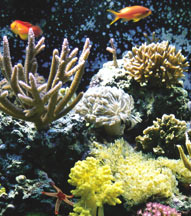|
Refocus Your Efforts in Autumn
Autumn is an ideal time to step up your focus on your aquarium. It's the time to look over your system top to bottom and catch up on routine maintenance you may have let slide in order to enjoy time outdoors over the summer.
Start with the foundation of your system - your equipment. Check all devices to make sure they are working properly. Also, find out if they are still performing efficiently. The Neptune Systems Next Generation Apex WiFi Aquarium Controller System is a great way to check. It measures energy consumption and can be an invaluable tool in alerting you to energy-stealing equipment that is costing you dearly in electric bills.
 It's also a good time to dust your exterior equipment, untangle and tidy up cords, and ensure nothing is impeding equipment that requires good ventilation. Inspect tubes to make sure connections are tight, no kinks exist in the line, and that all passageways are free of debris. Take the time to disassemble tubing and run a bottle brush type cleaning brush or a magnetic aquarium tubing cleaner through them. Check your filter housing, as well as other submersed equipment. Remove algae and other deposited debris with an easy-cleaning mitt or algae scraper. Remove and clear your protein skimmer's collection cup as you usually do on a weekly basis, and adjust the flow regulator to optimize bubble size. Inspect and clean the skimmer's
pump.
It's also a good time to dust your exterior equipment, untangle and tidy up cords, and ensure nothing is impeding equipment that requires good ventilation. Inspect tubes to make sure connections are tight, no kinks exist in the line, and that all passageways are free of debris. Take the time to disassemble tubing and run a bottle brush type cleaning brush or a magnetic aquarium tubing cleaner through them. Check your filter housing, as well as other submersed equipment. Remove algae and other deposited debris with an easy-cleaning mitt or algae scraper. Remove and clear your protein skimmer's collection cup as you usually do on a weekly basis, and adjust the flow regulator to optimize bubble size. Inspect and clean the skimmer's
pump.
Lamp Changes
Lamp effectiveness declines with time, so check that you're not operating lamps past their useful life. If you cannot remember the last time you made a bulb change, it is probably time for a new one. We recommend a UV lamp change every 6 months for optimum performance, but some models can be used for up to a year.
Filter Media
Replace any clogged filter pads or cartridges to keep your
mechanical filtration in tip-top shape. If necessary, change specialized media such as activated carbon, peat, or phosphate removers.
Though Bio Balls and other biological media do not require replacement, they occasionally clog with debris, decreasing water flow. If this happens, you can rinse them (with aquarium water only). It's a good idea to use a Live Nitrifying Bacteria or Stress Zyme after this process.
Aquarium Cleanup - Inside and Out
Use a magnetic aquarium glass scrapper or similar device to remove algae buildup on the interior aquarium walls. A siphon style water changer offers an easy way to remove unsightly detritus and muck from aquarium substrate. If you haven't performed a water change recently, this is a good time to siphon the aquarium down by 30%. (Make sure you have pre-mixed saltwater or RO filtered freshwater on hand.) Next, clean the outside of the aquarium, as well as your lighting fixtures. Avoid using harsh chemical cleansers; our nontoxic aquarium wipes are perfect for this job.
Remember to perform a water test before and after to make sure your crucial parameters are in optimum range.
Test kits alert you to problems with your biological filtration, water chemistry, and other factors that can be detrimental to the health of your fish. Testing takes away the guesswork, so you can promptly make adjustments to ensure the least stressful environment for your fish.
It's also a good idea to keep a written log of your observations and test results. Record these observations in a simple notebook and store it in the cabinet with your fish supplies.
Staying on top of maintenance helps prevent aquarium emergencies, and the fruit of your labor is a visually appealing, healthy display.
|